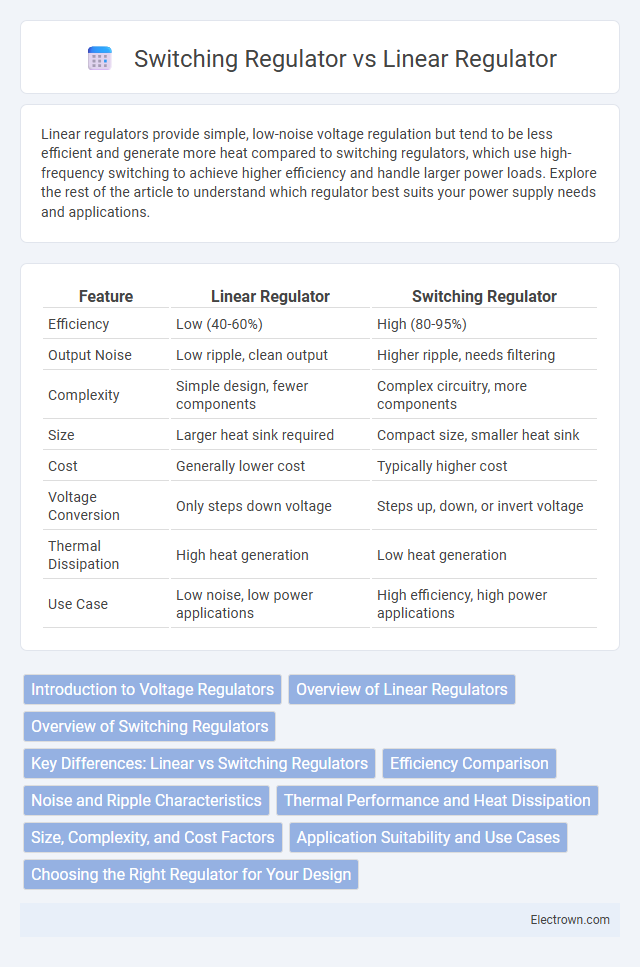Linear regulators provide simple, low-noise voltage regulation but tend to be less efficient and generate more heat compared to switching regulators, which use high-frequency switching to achieve higher efficiency and handle larger power loads. Explore the rest of the article to understand which regulator best suits your power supply needs and applications.
Table of Comparison
| Feature | Linear Regulator | Switching Regulator |
|---|---|---|
| Efficiency | Low (40-60%) | High (80-95%) |
| Output Noise | Low ripple, clean output | Higher ripple, needs filtering |
| Complexity | Simple design, fewer components | Complex circuitry, more components |
| Size | Larger heat sink required | Compact size, smaller heat sink |
| Cost | Generally lower cost | Typically higher cost |
| Voltage Conversion | Only steps down voltage | Steps up, down, or invert voltage |
| Thermal Dissipation | High heat generation | Low heat generation |
| Use Case | Low noise, low power applications | High efficiency, high power applications |
Introduction to Voltage Regulators
Voltage regulators maintain a constant output voltage despite variations in input voltage and load conditions, ensuring stable power supply for electronic circuits. Linear regulators operate by dissipating excess voltage as heat through a series pass element, offering simplicity and low noise but lower efficiency. Switching regulators use high-frequency switching and energy storage components such as inductors and capacitors to convert voltage efficiently with minimal heat dissipation, making them ideal for high power applications.
Overview of Linear Regulators
Linear regulators provide a simple and cost-effective solution for voltage regulation by using a variable resistance to maintain a constant output voltage. They operate with low noise and minimal electromagnetic interference, making them ideal for sensitive analog circuits requiring clean power. Your design benefits from their easy implementation and fast transient response, although they are less efficient for large voltage drops compared to switching regulators.
Overview of Switching Regulators
Switching regulators efficiently convert electrical power by rapidly switching transistors on and off, resulting in higher efficiency compared to linear regulators. They use components like inductors, capacitors, and diodes to store and transfer energy, enabling voltage step-up, step-down, or inversion. Your choice of a switching regulator is ideal for applications requiring efficient power conversion and minimal heat dissipation.
Key Differences: Linear vs Switching Regulators
Linear regulators provide a simple, low-noise solution by dissipating excess voltage as heat, making them ideal for low-power applications requiring clean output. Switching regulators, also known as DC-DC converters, offer higher efficiency by rapidly switching input voltage on and off and using inductors and capacitors to maintain output, effectively minimizing power loss in high-current scenarios. The key differences lie in efficiency, heat dissipation, complexity, and noise, with linear regulators favored for simplicity and low noise, while switching regulators excel in energy efficiency and handling higher power levels.
Efficiency Comparison
Linear regulators offer simplicity and low noise but typically operate with efficiency between 40% to 60%, as they dissipate excess voltage as heat. Switching regulators achieve higher efficiency, often ranging from 80% to 95%, by converting voltage through high-frequency switching and energy storage elements. The significant efficiency advantage of switching regulators makes them ideal for battery-powered and high-power applications, reducing thermal management requirements.
Noise and Ripple Characteristics
Linear regulators produce low noise and minimal ripple due to their continuous conduction mode and simple design, making them ideal for sensitive analog circuits. Switching regulators generate higher noise and ripple because of their switching action and high-frequency operation, which can cause electromagnetic interference without adequate filtering. Your choice depends on whether low noise or efficiency is the priority for your specific application.
Thermal Performance and Heat Dissipation
Linear regulators exhibit lower thermal efficiency due to continuous power dissipation as heat, especially when the voltage drop between input and output is significant, resulting in larger heat sinks and cooling requirements. Switching regulators, such as buck or boost converters, achieve higher thermal performance by rapidly switching transistors on and off, greatly reducing power loss and heat generation, allowing for smaller heatsinks and improved energy efficiency. The overall heat dissipation in linear regulators is proportional to the product of voltage drop and output current, whereas switching regulators minimize this by converting voltage through energy storage elements with minimal losses.
Size, Complexity, and Cost Factors
Linear regulators are typically smaller and simpler in design, making them ideal for applications where space and minimal circuitry are critical. Switching regulators, though more complex and larger due to inductors and additional components, offer higher efficiency and can handle a wider input voltage range, reducing overall system cost in high-power applications. Your choice between the two depends on balancing size constraints and cost with the required power efficiency.
Application Suitability and Use Cases
Linear regulators provide low-noise, stable output voltage ideal for sensitive analog circuits and low-power applications, such as precision instrumentation and audio devices. Switching regulators excel in efficiency and power conversion for high-current applications like battery-powered systems, DC-DC converters, and renewable energy solutions. Your choice depends on whether noise reduction or energy efficiency is the primary requirement for your electronic design.
Choosing the Right Regulator for Your Design
Selecting the right regulator for your design depends on efficiency, noise sensitivity, and power requirements. Linear regulators offer simplicity and low noise, making them ideal for low-power, noise-sensitive applications, but they are less efficient with higher voltage drops. Switching regulators provide higher efficiency and better thermal performance for high-power designs but may introduce electromagnetic interference that requires careful filtering.
Linear Regulator vs Switching Regulator Infographic

 electrown.com
electrown.com